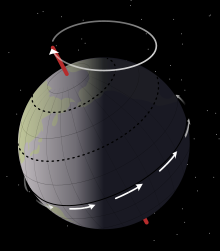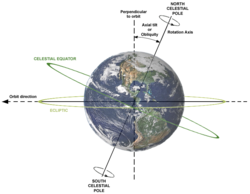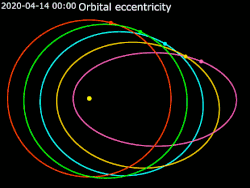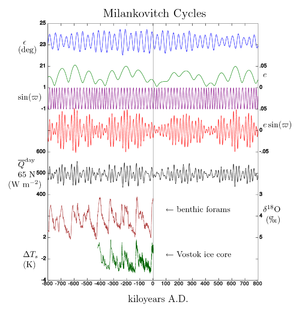Planet Earth/1h. Milankovitch cycles: Oscillations in Earth’s Spin and Rotation
The heavy iron door closed behind me....I sat on my bed, looked around the room and started to take in my new social circumstances… In my hand luggage which I brought with me were my already printed or only started works on my cosmic problem; there was even some blank paper. I looked over my works, took my faithful ink pen and started to write and calculate… When after midnight I looked around in the room, I needed some time to realize where I was. The small room seemed to me like an accommodation for one night during my voyage in the Universe.—Milutin Milanković, Summer 1914
Milutin Milanković: The Imprisoned Scientist
[edit | edit source]
Arrested and imprisoned while returning from his honeymoon, in summer of 1914, Milutin Milanković found himself alone in his prison cell. As a successful engineer and expert in concrete and bridge building, Milutin was wealthy, in love with his new wife, and hopelessly obsessed about a cosmic scientific program that wrestled his mind even as he was being imprisoned. Milutin was born in Serbia and had taken a position as the Chair of Mathematics across the border in the Austro-Hungarian city of Budapest, the same year that Gavrilo Princip, a Serbian, assassinated the heir to the Austro-Hungarian throne, Archduke Franz Ferdinand. The assassination would plunge the globe into the first World War. And as a Serbian returning to the Austro-Hungarian Empire, Milutin was arrested and placed in jail. His new wife, Kristina Topuzovich, implored the authorities to let her husband go, but as the hostilities between nations escalated during the summer, his chances of release diminished. Milutin Milanković was singularly obsessed with a problem in science, and it had to do with the motion of the Earth through space. In the years leading to 1914, scientists had discovered that the Earth had experienced large widespread Ice Ages in its recent past. Cold periods of time which had lengthened glaciers, carved mountains, and deposited large boulders, which covered the landscape of northern Europe and North America in giant ice sheets. Geologists around the Northern Hemisphere had discovered strong geological evidence for these previous episodes of ice ages, yet climate scientists had yet to discover a reason why they had occurred. Milutin had wrestled with the idea, and wondered if it had to do with long term cycles in Earth’s orbit.
Earth’s Tilt Causes the Seasons
[edit | edit source]
The winter and summer months are a result of Earth’s tilt of 23.5 degrees, such that as Earth rotates around the Sun during the months of June, July, and August the Northern Hemisphere points toward the sun, lengthening the Solar Day. While in December, January, and February the Southern Hemisphere points toward the sun lengthening the day in the Southern Hemisphere. Milutin wondered if there was a similar but much longer orbital cycle with Earth that would cause a long-term cycle of ice ages.
Earth’s Precession
[edit | edit source]Before his imprisonment, Milutin begun studying something called Earth’s Precession. For nearly two thousand years, astronomers mapping the stars had made note of a slight shift in the position of stars in the night sky. The position of Earth’s axis relative to Polaris (the North Star), appears to move in a circular path in the night sky, which is estimated to complete a circle in 25,772 years. This odd observation also helps to explain the peculiar fact that the Sidereal Year, when a star returns to the exact same position in the night sky after a full rotation around the sun and the Solar Year (also called a Tropical Year) when the sun returns to the exact same position in the day time sky (noon between two summer solstices) is about 21 minutes shorter. This 21 minutes shorter Solar Year reflects this slight wobble with Earth’s orbit, which was called a precession cycle. After 25,772 years the position of the stars and the solstice will return to their original starting positions.

The best way to explain the axial precession cycle is to watch a spinning top or gyroscope, which tends to wobble during its spin, such that the axis of the spin rotates in a circle when viewed from above. Milutin realized that this cycle could be the clue to unlock the reason for the ice ages in Earth’s past, because it was an example of a long-term orbital cycle, however it was not the only one.
This precession of Earth’s orbit was first recognized with the vernal and autumnal equinoxes, called the Precession of the Equinoxes. As the Earth spins, the Sun’s path forms a great-circle referred to as an ecliptic around the Earth. The celestial equator is a great-circle projecting out from Earth’s equator onto the starry night sky. The angle between these two great-circles is 23.5°, the tilt of the Earth’s axis. When these two great circles intersect, determined by observing the rising sun relative to the background stars, defines the equinox. The equinox occurs when the Earth’s tilt is perpendicular to the direction toward the sun, and the days are equal length across the Earth. This occurs around March 21st and September 23rd. However, astronomers noticed that the background stars that forecast the coming of the equinox was shifting. Resulting in a Precession of the Equinoxes in the night sky. Of course, this is a result of the axial precession, which shifts the ecliptic relative to the celestial equator, as well.

Milutin realized that during this cycle, the axis of the Earth would project more toward the sun and further from the sun at different times of the year. For example, there would be a period of several thousand years when the North Hemisphere would wobble more toward the sun during the summer (making it hotter), and a period of several thousand years when the North Hemisphere would wobble away from the sun during the winter (making it colder).
Earth’s obliquity
[edit | edit source]Working with the University, Milutin’s wife arranged for Milutin to be transferred to the library at the Hungarian Academy of Sciences. He was forbidden to leave and was under guard during the War, but allowed to continue his research.

Earth’s precession was not the only long-term variation in Earth’s orbit. The tilt of Earth’s orbit oscillates between 24.57° and 22.1°, with a current tilt of 23.43677° and is slowly decreasing. This shift in the tilt of axis completes a cycle about every 41,000 years. This is referred to as Earth’s obliquity. The first accurate measure of Earth’s tilt was determined by Ulugh Beg (الغ بیگ), who built the great Samarkand Observatory, in present day Uzbekistan. His calculation of 1437 CE was 23.5047°, indicating a decrease of 0.06783° over 583 years, indicating a complete cycle of 42,459 years for Earth’s obliquity. The oscillations in Earth’s tilt would result in more severe winters and summers during these long-periods of several thousand years when Earth’s tilt was greater. While in the library, Milutin pondered the effect of Earth’s changing obliquity on Earth’s climate and moved onto a third orbital variation.
Earth’s Eccentricity
[edit | edit source]
Red=0.0 Green=0.2 Blue=0.4 Yellow=0.6 and Pink=0.8
The third long-term variation in Earth’s orbit that Milutin examined was the shape of Earth’s elliptical orbit around the sun. During this yearly orbit around the sun, the Earth is closest to the sun at the perihelion (which occurs around January 4th), and furthest from the sun at the aphelion (which occurs around July 5th). Mathematically we can define a term for circles called eccentricity. When eccentricity is zero, the circle will be a perfect circle, the difference between the distances across the widest part of the circle and the narrowest part of the circle is zero. If we define the circle as actually an ellipse, rather than a perfect circle, the difference between the widest part of the ellipse and the narrowest part of the ellipse will be greater than zero, we call this difference eccentricity.
To measure Earth’s eccentricity requires that we observe the daily path of the sun’s shadow for a full year and determine the precise time it reaches its highest point in the sky (shortest shadow each day). The difference from the local noon time, and when it is observed at the highest point in the sky will shift slightly through the year. This is because the Earth’s path relative to the Sun will have slight differences in velocity as Earth moves around the Sun over a year along this elliptical path. Sometimes the Earth will be slower, during the narrow width days, and sometime faster during the wider width days of the year. The differences in local noon time, and observed solar path can be used to determine Earth’s eccentricity, which is currently 0.0167. It is nearly a circle, but not exactly.

Another way to measure the Earth’s eccentricity is to measure the width and shape of the analemma of the Sun each day of the year. This is the position in the sky each day that the sun reaches its highest point. The shape of the analemma is dependent on the elliptical path of the Earth around the Sun, and will result in a path looking like the figure 8 for eccentricity less than 0.045. However as Earth’s eccentricity approaches 0.045 or greater it will become more tear-drop in shape with no intersection.
Earth’s eccentricity oscillates between 0.057 and 0.005, which means that sometimes Earth will be more circular in its path around the sun, and sometimes more elliptical. When the eccentricity is greater, Earth will be further and closer to the Sun during those points in its orbit. In the Northern Hemisphere, the perihelion occurs in the winter, resulting in a milder winter, while the aphelion occurs in the summer, resulting in a cooler summer. When eccentricity is less, the winters and summers will be colder and hotter in the North Hemisphere, but the opposite in the Southern Hemisphere. However, the distance to the sun oscillates only several thousand kilometers, and has a fairly mild effect on climate. The eccentricity cycles between its extremes every 92,000 years, although it oscillates in an odd pattern because these changes in eccentricity are due to the interaction of Earth with other planets in the solar system, particularly Mars, Venus, and Jupiter, which pull and tug at Earth, stretching Earth’s yearly orbital path around the sun. The largest planets such as Jupiter and Saturn also tug on the sun. Hence astronomers define something called the barycenter of the solar system. A barycenter is defined as the center of mass of two or more bodies in orbit with each other. When the two bodies are of similar masses (such two stars) the barycenter will be located between them and both bodies will orbit around it. However, since the sun is much much larger than the planets in the solar cycle, the barycenter is a moving point orbiting near sun’s core. This is what causes the changes in eccentricity, as Jupiter and Saturn (and other planets) tug and pull on Earth and the Sun, causing the center of the solar system not to be exactly in the direct center of the sun.
The three major orbital influences on Earth’s climate
[edit | edit source]
Milutin Milanković was released after the war, and applied his mathematical knowledge to better understand Earth’s past climate. He did this by looking at the mathematical summation of these three major orbital influences on Earth. By combining these three long-term orbital variations, he laid out a prediction for scientists to determine Earth’s oscillations with its climate over its long history. His publications and notes on Earth’s motion and its relationship to long-term climate was published in book form in 1941 in German, entitled Kanon der Erdbestrahlung und seine Anwendung auf das Eiszeitenproblem (The Canon of the Earth’s Irradiation and its Application to the Problem of Ice Ages). Milanković mathematically predicted oscillations of Earth’s climate and long-term cycles that have been verified repeatedly in ice core data, and ancient sedimentary rocks, which show these long-term cycles in Earth’s orbit, which today we call Milanković Cycles.
| Previous | Current | Next | |
|---|---|---|---|
|
g. Coriolis Effect: How Earth’s Spin Affects Motion Across its Surface. |
h. Milankovitch cycles: Oscillations in Earth’s Spin and Rotation. |
